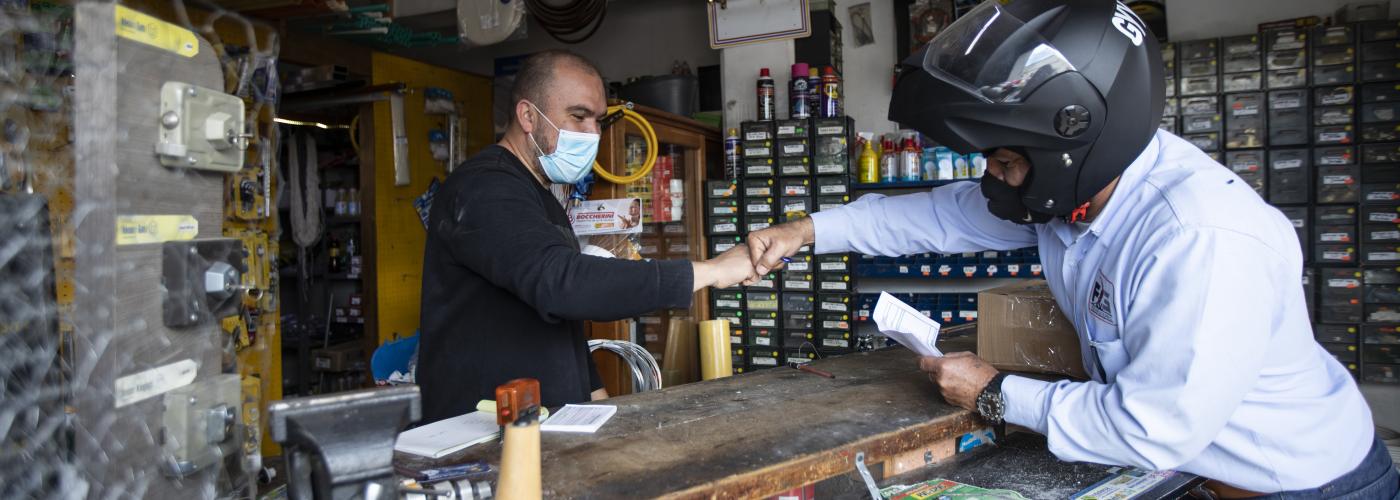Financially Including Migrants, a Familiar but Unique Challenge
Image

This blog was authored by Chemonics.
Since 2014, hyperinflation, corruption, supply shortages, and violence in Venezuela forced over 6 million people to leave their homes in search of safety and opportunity. Hosting over 1.6 million Venezuelan migrants, Colombia has the largest population of Venezuelans in the world outside of Venezuela. In 2021, Venezuelan migrants in Colombia received temporary protected status, giving regular and irregular migrants access to jobs, education, health, and financial services. Despite the widely lauded migrant-forward national policies, migrants still face barriers to finance because they lack financial history, have limited collateral, and have informal businesses and jobs. These barriers are compounded by xenophobia and perceptions of migrants as transient high-risk borrowers.
To address these barriers, the USAID Colombia Rural Finance Initiative (RFI), a financial inclusion project implemented by Chemonics International, received an 18-month extension period to help financial institutions reach 43,816 new Venezuelan migrant clients and mobilize $11 million in finance. Below, we summarize four key lessons learned through this work that development practitioners should consider when designing and implementing programs to financially include migrants.
1. Understand the market dynamics
The RFI project prioritized understanding the regulatory barriers that migrants faced to underpin its migrant inclusion approach. Although Colombia had nationally adopted migrant-friendly policies, the RFI project learned that many financial institutions’ internal policies and procedures were not migrant-inclusive.
What worked well?
- Leaning on the financial institutions’ internal units to understand their regulatory frameworks, policies, and practices and identify changes that would enable them to serve migrants.
- Assessing the migrant population and segmenting migrants helped financial institutions create demand-driven financial services and products (remittances for recent arrivals, checking accounts for employees, and credit for business owners).
What did not work as planned? - The RFI project’s initial assumption was that the main barrier to migrant financial inclusion was the lack of migrant identification, which was not true in Colombia.
2. Build the business case
Recognizing that financial institutions do not always perceive migrants as attractive clients, the RFI project had the challenging task of generating interest among financial institutions to expand their services and products to migrants.
What worked well?
- Presenting a business case to financial institutions that included migrant inclusion as part of a broader strategy to increase their competitiveness.
- Choosing different types of financial institutions – like fintechs, cooperatives, microfinance institutions, and commercial banks – to implement a migrant inclusion strategy that was responsive to migrants’ different financial needs.
What did not work as planned?
- Generating interest from large commercial banks that had more rigid internal processes and did not prioritize migrant inclusion as part of their business model.
3. Offer bespoke technical assistance
The RFI project used technical assistance and grants to strengthen financial institutions’ migrant inclusion strategies. By creating business-driven work plans for each financial institution, the project tailored their technical assistance to focus on the individual risk and cost factors that prevented that financial institution from lending to migrant clients. RFI used grants to encourage financial institutions to adopt new technologies, like adding features to banking platforms designed specifically for Venezuelan migrants.
What worked well?
- Using profiling data on migrants to show financial institutions that while migrants are diverse and have unique needs, they also share characteristics with the Colombian rural clients they were already working to financially include.
- Training fintechs, who were experts in payments and deposits and were quick to offer financial services and products to migrants, on how to offer credit products and conduct risk assessments, recover portfolios, and manage credit related operations.
What didn’t work as planned?
- Leaning on migrant organizations to lead the relationship management between migrant groups and financial institutions.
4. Match the demand and supply
To complement the efforts to increase supply of finance for migrants, RFI worked with financial institutions to launch financial literacy and awareness campaigns for migrants.
What worked well?
- Creating a Financial Education for Migrants guide, in collaboration with other donors and stakeholders, that explained the types of financial institutions that serve migrants and what products and services are accessible to them. More importantly, the primer included information on eligibility requirements so that migrants understood how they could access those financial services and products.
- Using Facebook and Whatsapp – Venezuelan migrants’ most popular channels – to build financial literacy and share new financial products and services with the migrant population.
What didn’t work as planned?
- Launching marketing campaigns that were too broad and introduced new products without being specific about who was eligible, how to apply, or how the products and services could be used.
With millions of Venezuelan migrants in the Colombian economy, financially including migrants will stimulate businesses growth, create new jobs, and accelerate economic growth that will benefit all of Colombia. Despite the macroeconomic benefits of migrant inclusion, mobilizing finance to migrants requires aligning incentives between profit-driven financial institutions who perceive migrants as high-risk clients (supply of finance) and finance-seeking migrants (demand of finance). Donor projects can help bridge this gap on the supply side by providing technical assistance and incentive grants to help financial institutions lower risk and cost factors and unlock financing for migrants. On the demand side, projects can help strengthen financial literacy and create awareness campaigns on new migrant-friendly financial services and products. To explore more about the Colombia Rural Financial Initiative’s approach to migrant financial inclusion, and learn from others working on similar activities, join the upcoming Mobilizing Finance to Migrant Communities (and Beyond) webinar hosted by Chemonics and the USAID Private Sector Engagement Hub on October 27, 2022.

